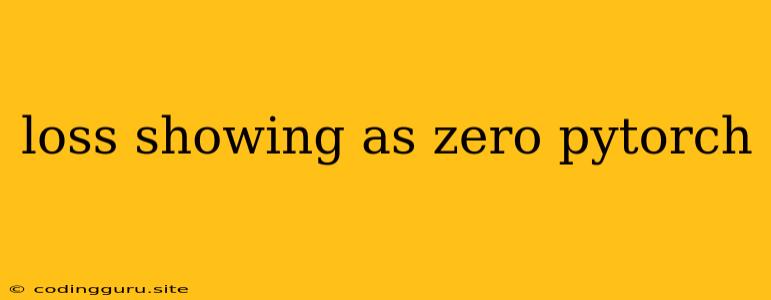Why is my loss showing as zero in PyTorch?
Seeing a zero loss in PyTorch can be a perplexing experience. While it might seem like a good thing initially, it often signals a deeper problem within your model training process. This article delves into the common reasons behind this phenomenon and provides practical solutions to help you debug and overcome this issue.
Understanding the Significance of Loss
Loss is a fundamental concept in deep learning. It quantifies how far your model's predictions deviate from the actual target values. This deviation is then used to adjust the model's parameters via an optimization algorithm, like Stochastic Gradient Descent (SGD). A zero loss, therefore, implies that your model is perfectly predicting the target values, which is rarely the case in real-world scenarios.
Possible Reasons for Zero Loss
- Initialization Issues:
- Zero Weights: If your model's weights are initialized to zero, the gradients will also be zero, leading to no parameter updates and a constant zero loss.
- Incorrect Initialization: Initializing weights with extreme values can cause the model to get stuck in a local minimum where the loss remains zero.
- Learning Rate Problems:
- Learning Rate Too Small: A very small learning rate might result in negligible parameter updates, leading to a zero loss plateau.
- Learning Rate Too Large: An overly large learning rate could cause the model to "jump" over the optimal parameter values, resulting in oscillations and eventually, zero loss.
- Data Issues:
- Perfect Dataset: If your training dataset is already perfectly labeled, your model might learn to predict the target values perfectly, resulting in zero loss. This is unlikely in practical scenarios.
- Data Imbalance: A highly imbalanced dataset might cause your model to prioritize predicting the majority class, leading to zero loss for that class but significant errors for minority classes.
- Model Architecture:
- Overfitting: Your model might be overfitting to the training data, resulting in a zero loss on the training set but poor performance on unseen data.
- Too Simple Model: A model that is too simple for the task might fail to learn the underlying relationships and end up with a zero loss due to a lack of capacity.
- Code Bugs:
- Incorrect Loss Function: Using a loss function that is not appropriate for your problem can lead to inaccurate loss calculations.
- Incorrect Data Preparation: Errors in data preprocessing, such as normalization or scaling, can lead to unexpected behavior and a zero loss.
Troubleshooting Steps
- Inspect Model Weights: Check if the initial weights are indeed zero or extremely large.
- Adjust Learning Rate: Experiment with different learning rate values to find the optimal setting for your problem.
- Analyze Data: Evaluate the distribution of your training data, particularly for class imbalance.
- Simplify the Model: If your model is complex, try simplifying its architecture to identify if it's overfitting.
- Examine the Loss Function: Ensure you are using the appropriate loss function for your task.
- Check Data Preprocessing: Scrutinize your data preprocessing steps to rule out any errors.
- Debug the Code: Carefully examine your code to identify any potential bugs that might be causing the issue.
Strategies to Avoid Zero Loss
- Regularization: Techniques like L1 and L2 regularization can prevent overfitting by adding a penalty to the magnitude of model weights.
- Dropout: Introducing dropout randomly disables a percentage of neurons during training, reducing the model's dependence on any single neuron.
- Early Stopping: Monitor your model's performance on a validation set and stop training when the validation loss stops improving.
- Data Augmentation: Expanding your dataset by generating artificial variations of existing data can help to mitigate overfitting and prevent the model from relying too heavily on specific patterns in the training data.
Example Scenarios
- Binary Classification with Imbalanced Data: If your dataset contains a significant imbalance between positive and negative classes, your model might be predicting only the majority class, resulting in a zero loss for that class but poor performance for the minority class. In such cases, you should consider techniques like oversampling, undersampling, or cost-sensitive learning.
Conclusion
A zero loss in PyTorch, while tempting to interpret as a sign of success, often indicates an underlying problem with your model training process. By understanding the common reasons behind this behavior and employing the troubleshooting strategies outlined above, you can effectively diagnose and resolve this issue. Remember, a robust model should be able to generalize well to unseen data, not just achieve zero loss on the training set.
